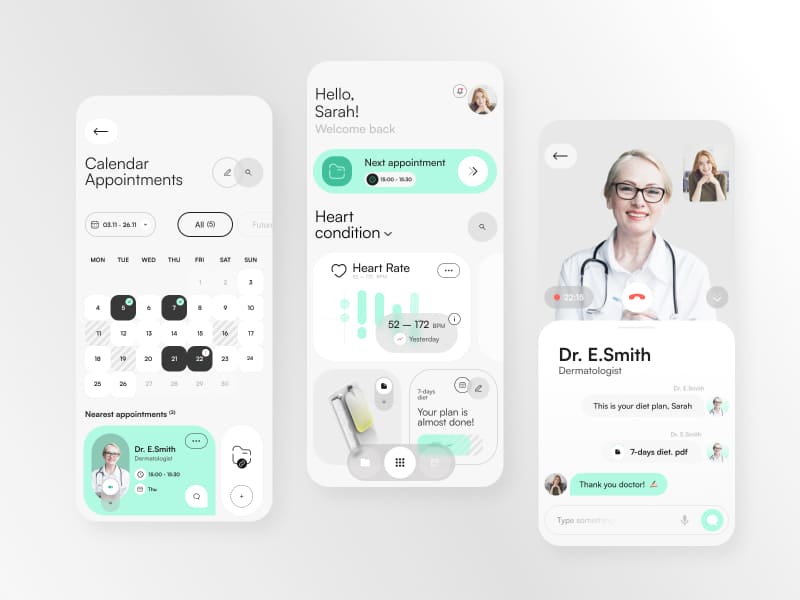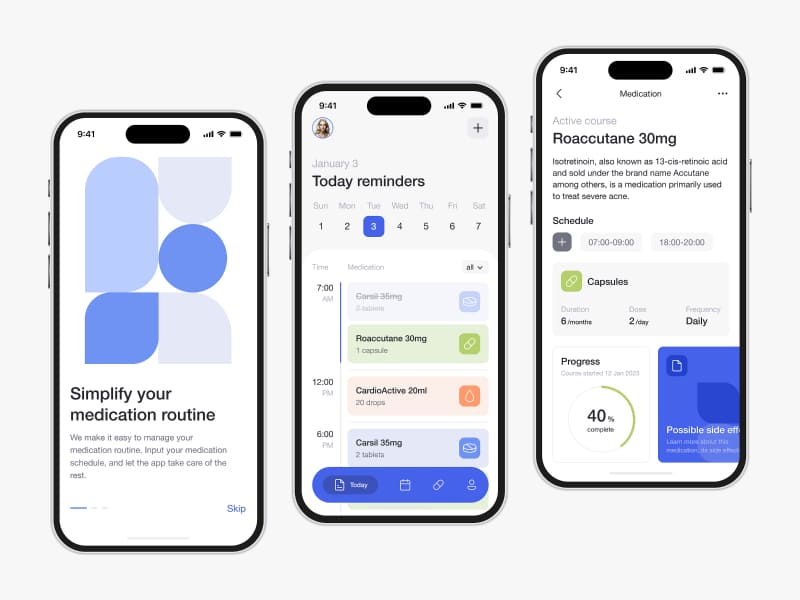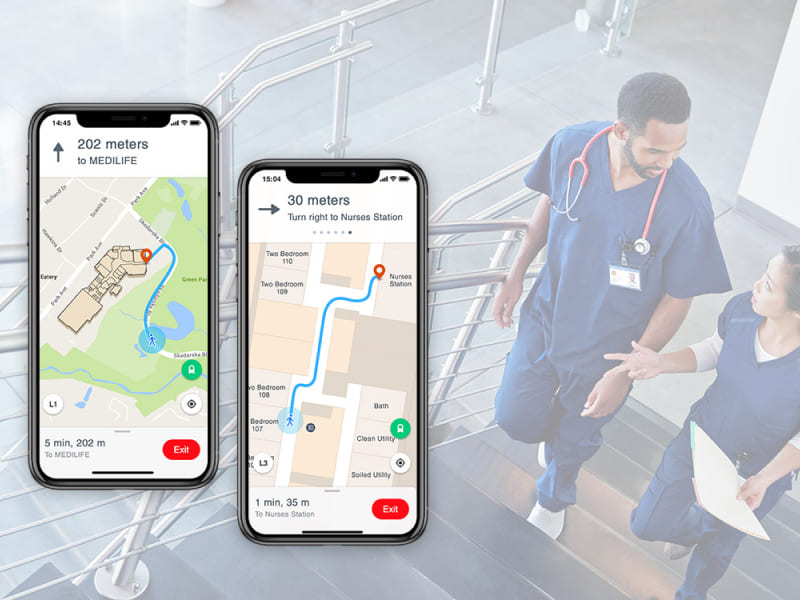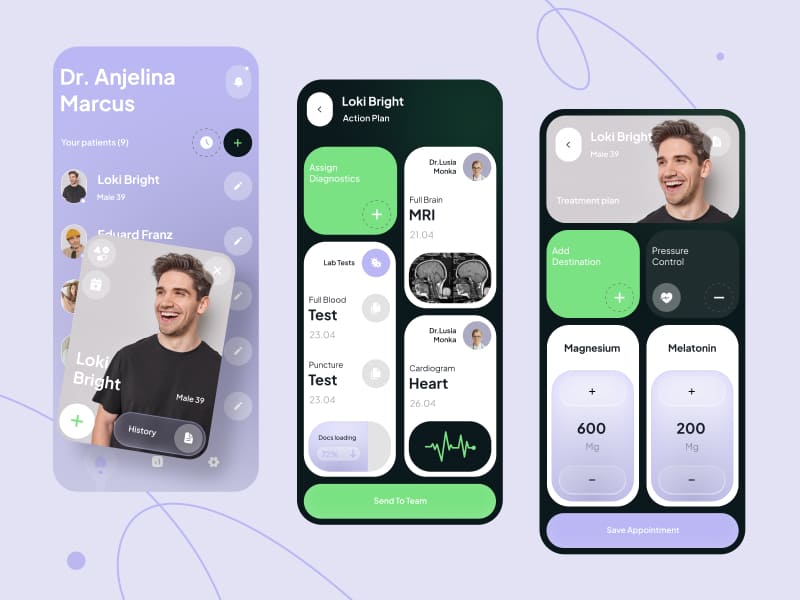
Table of Content
1. Telemedicine Feature
2. E-prescription
3. Pill reminder
4. Hospital Maps
5. Patient Dashboard
6. Doctor Dashboard
Introduction:
Healthcare industry making headlines since 2020! Yes. More than ever, this decade is recording a sharp surge in Healthcare technology.
Just imagine, a decade ago, if you were told a mobile app, through a wearable device, can monitor your BP, heart rate, sleep quality & can remind you to take pills, hydrate, move enough, rest enough, what would you have thought? You would have simply laughed it away.
But today, reports say, 2 in 5 adults in America are using a healthcare app, indicating that the need for smart assistance in healthcare has gone exponentially high.
If not for the pandemic, people wouldn’t be adapting to healthcare apps at this phase. Isn’t it? So, thanking the pandemic and moving on to the interesting topic of today which is, “Top 5 most useful healthcare mobile-app features” that are aimed at improving the lives of patients and easing the lives of doctors.
If you are planning to build your own healthcare app and if you want your app to be the most preferred one, make sure you have the following features integrated!!
For those who want to build an app but, confused about where to get started, here is how you do it: get the help of professionals at Zazz. Schedule a call with them as it costs nothing but your time.
1. Telemedicine Feature

Telemedicine has completely altered the course of consultation paving way for feasible yet effective treatment.
How does this feature work?
The process is pretty straightforward.
- The patient has to answer a few automated questions regarding the symptoms.
- Choose a doctor from the list of available doctors from acupunture programs, massage therapy services, MBBS professionals, and more.
- Choose a convenient time for video consultation
- Once the doctor accepts the consultation request, the patient will receive a confirmation mail.
Uses:
- It is the safest option to treat patients with Chronic illness, specifically the ones with diseases that are contagious, because telemedicine prevents the risk of spreading infection.
- It certainly eliminates the stress of both doctors and patients by allowing them to virtually connect, breaking the geographical barrier and thereby making the consultation convenient for both parties.
- Patients who are disabled, patients who are old can benefit the most out of it.
Related reading: Top Healthcare App Developers in USA
Pro Tip to build a better healthcare app: Have your patients in mind- make sure the interface and navigation caters to the needs of all age groups. A patient-friendly interface with multiple language support is much appreciated.
In case you need assistance on building healthcare mobile apps, Zazz is always there to support.
2. E-prescription

When it comes to prescription, there’s one universal fact which no one can disagree with. – ie.,
No handwritten prescription by any doctor can ever be understood by patients. The illegibility is real.
While this is enough to say why e-prescriptions are very useful, there are many other reasons that prove e-prescription is one of the best features that patients get to enjoy on a healthcare app.
How does it work?
Once the patient is done with consultation, their prescribed medicines will be uploaded on their respective healthcare app for ease of access. It also generates medication and dosage chart. With every visit, the prescription will be updated which they can download and share via any messaging channel. In-built stock availability look-up across pharmacies – Using this, patients can find out which pharmacy near them has their medication in stock.
Uses:
- Makes it easy for the doctors to track and understand patients’ medication history
- Zero chance of losing the prescription or tampering the prescription
- Zero possibility for medication errors
- Zero occurrence of underprescription or overprescription as everything is digitally recorded
- No defaulting will happen at the end of healthcare providers in terms of tracking the patients’ progress and altering the prescription accordingly.
Statistically, across the world, every individual who is past 50 is subjected to lifetime medication and takes at least 3 tablets a day. If you remember, your grandparents or parents used to carry a tampered handwritten prescription to the pharmacy everytime to renew their medication. But, now, e-prescription comes in handy which can be accessed from anywhere and can be stored in the database of any pharmacy.
Related reading: Developing a Healthcare App – A Complete Guide
3. Pill reminder

This feature is quite a savior for patients who are forgetful. Patients’ austerity (especially the ones with chronic illness) towards medication is crucial to control the condition and improve longevity. Pill reminder is one best feature to keep medication routine under check.
How does this work?
Quite simple. This works just like an alarm clock.
It takes the input from the e-prescription and sets automated reminders on its own. Or, patients can go to the reminder settings, set their own time intervals for reminder and save. Though it has a default reminder frequency, patients can alter it based on their requirement.
Uses:
- The automated push notification is to make sure that the reminder never goes unnoticed by patients
- The convenience to edit or change the reminder settings according to individual’s routine
- Based on how patients are interacting with the push notifications, it sends them an automated report on their pill consumption pattern.
- It helps patients to consciously practice taking medications on time which in turn will minimizes the risk that comes with skipping medication.
Related reading: The pivotal role of cloud computing in the healthcare sector
4. Hospital Maps:

Even the most oriented person can get lost in the maze of multi-speciality hospitals. Don’t you agree? Having a hospital map on a healthcare app is quite a relief.
How does it work?
It displays the complete structure of the hospital with landmarks
Sends location based notifications
Sends off route notification
Saves the route for hassle free navigation during the next visit
Uses:
Helps in improving walk-in experience of the patients
Improves safety and accessibility
Aids the hospitals in effective administration
Related reading: How Mobile Apps are Transforming The Healthcare Industry
5. Patient Dashboard

A great feature to organize and maintain patient records.
How does it work?
This feature gives doctors an overview of patients’ clinical history including, diagnosis history, prescription history, lab results etc.,as well as their personal information. It tracks their check up frequency, tracks their medication consumption pattern and gives doctors a consolidated view of patient data on a single dashboard.
Uses:
This personalized feature helps doctors to study and treat patients better
Helps doctors manage their appointments
Minimizes prescription errors
Related reading: Building Custom Medical Billing Software: A Complete Guide
6. Doctor Dashboard

Earlier, if you have to visit a doctor, you have no other choice but to choose the ones who live in the proximity. You tend to stick to that doctor irrespective of the symptoms.
The doctor dashboard feature on a healthcare app lets patients access a wide range of verified doctors’ profiles on a single dashboard which eases the consultation process.
How does this work?
Based on the symptoms that patients provide on the app, this feature displays the list of relevant doctors available. It displays the doctors along with their expertise so that patients can make an informed decision before booking their appointment. ‘Patient review’ would be an ad-on here. It also displays the contact details of the doctor for patients to directly approach them in case of emergencies.
Uses:
Improves patient experience
Reduces unwanted communication as the patients get to check their availability before they would want to walk-in.
Helps to figure out the patient-physician ratio
Helps in streamlining the practitioner hours.
Related reading: Insurance Mobile App Development Costs, Features, and Benefits
Conclusion:
Busy life, stress, physical ailments, population and many other factors have collectively led to the increase in usage of healthcare apps today. After all, the objective of any healthcare app is to make things easier for both doctors and patients. The above mentioned are some of the significant features that a healthcare app must have to improve the experience of patients as well as that of doctors.
Pro Tip: More than any app, healthcare apps are to be mindfully created. Zazz has got that craft and crew to create the most reliable healthcare app for you, which your patients and doctors would thank you for.
Recent Articles
Table of Content 1. Skills and Workforce Evolution 2. Top...
Table of Content 1. Data Engineer vs. Data Scientist: Understanding...
Table of Content 1. What is the Carnival in Brazil?...












